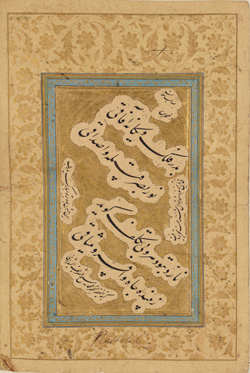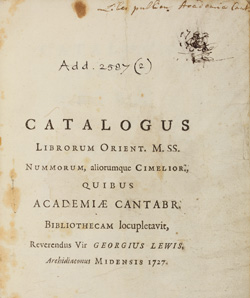The Archdeacon and his 'Bibliotheca Orientalis': George Lewis

A volume known as the ‘Lewis Scrap-Book’, containing letters and fragments of manuscripts in Persian, Arabic and Turkish, displaying many styles of Islamic calligraphy. MS Add. 254.
George Lewis’s valuable collection of 76 manuscripts, mainly in Persian, came to the Library in 1727 in a wooden cabinet inscribed ‘Bibliotheca Orientalis’.
Lewis (d. 1729) was educated at Queens’ College in the 1680s and subsequently entered the Church. He travelled to India in 1692 where he was Chaplain to the East India Company settlement in Madras until 1714. He was a gifted linguist, proficient in Persian, and during his stay in India he collected manuscripts which closely reflected his own interests and expertise. The collection is strong in religious texts (Qur’ans and translations of the Bible into Persian), manuscripts on grammar, and dictionaries, including Lewis’s own unfinished dictionary of Persian. Significantly, there are texts by poets such as Hātifī and Jāmī and a rare volume by Rahā’ī—the literary traditions of the Islamic world were little known in Europe at this date.
Along with the manuscripts came an assortment of curiosities: coins, weights, inscriptions, miniature Indian playing cards on wood and tortoiseshell, and a pair of embroidered slippers.

A contemporary printed catalogue of the manuscript collection, written by Lewis himself in 1727, providing a contents list with short descriptions. MS Add. 2587.











